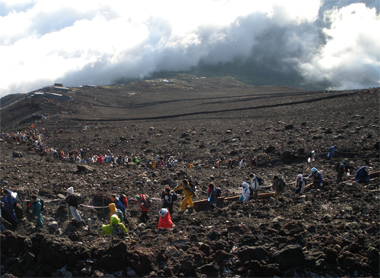
 View from the top of Mt. Fuji
View from the top of Mt. Fuji
Repeat after me: Kimonos, Karate and Karaoke…wasn’t that easy? The land of the rising sun has an abundance to offer so it’s no surprise that millions of tourists flock there every year. If you are considering a trip to Japan but the language barrier is immobilizing you-prepare to be convinced. With a little preparation and the following advice, you’ll survive and master traveling in Japan faster than you can say domo arigato (psss that means ‘thank you’). Ease your mind with the information and tips provided below about transportation, eating, accommodation and shopping in Japan without knowing Japanese.
Consider the transportation options
The size of Japan is comparable to the state of California. Keep this in mind when choosing your travel method from city to city. On the "mainland" you have five choices for transport; ferry, car, bus, airplane and train. The size of your wallet might have to take a back seat to convenience in this area. Bus transportation is cheaper than train or airplane travel but takes longer and schedules/bus terminals can be trickier to figure out.
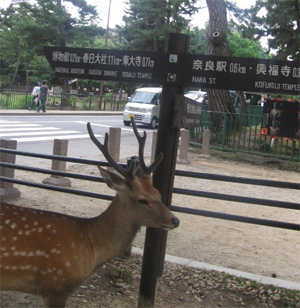
 Important signs are always also in English
Important signs are always also in English
Traveling by Shinkansen (bullet train) may be expensive but English signage and quick transport make touring Japan simple. Cars might be nice if you are heading to rural areas but you need a special license and watch out-they drive on the left side! Ferries from city to city are slower than the bullet train, but if you are traveling around various islands in Okinawa you obviously won’t have an alternative.
TIP: If you are staying more than 5 days and migrating long distances, the Japan rail pass might be more economical. Make sure you purchase the pass before you arrive, as it cannot be purchased in Japan. Check out the for more information.
Getting around
The first stop at any airport, train station or city center in Japan should be the Tourist Information Center or TIC. They usually speak English and even if you know where you are or what you are doing, a map can’t hurt. It’s especially helpful for transportation arrangements; bus numbers, how to buy tickets or where the taxi stand is located become easy with a TIC’s help. If you only have a short time in the city and want to arrange a tour, the TIC can arrange one with as many frills (or non-frills) as you would like.
TIP: If you have a couple of days in Tokyo during the summer think about a Mt. Fuji trip. Hike all night or sleep in a hut, but don’t miss the sunrise at the top! TIC can help you with tour bookings or you can arrange your own transportation at Shinjuko Station KEIO bus terminal. When buying tickets at bus terminals (for Mt. Fuji or anywhere else) have the dates and times written down. This makes it easier to communicate if the agent’s English is limited
The travel guidebook is your friend
A guidebook can be your saving grace in unexpected situations such as getting lost or late night arrival to a new area. Guidebooks provide maps, terminal locations and transport schedules as well as basic Japanese phrases. Certain guidebooks (such as Lonely Planet) are so comprehensive they make navigating through the country effortless.
Restaurants
Japanese dining cannot be missed. Don’t let not knowing Japanese characters and bad chopstick form get in your way! Smile, point, gesture and struggle through because visiting Japan without sampling the chow would be a major loss. Ask for an English menu or check out the numerous restaurants with plastic food displays.
Fast Food-Japanese Style
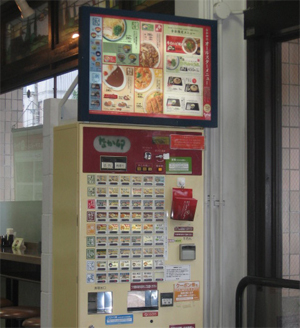
 Order your meal from this vending machine
Order your meal from this vending machine
Instead of McDonald’s, try the quick dining restaurants that use a vending machine method for ordering. Press the meal you want, insert the correct Yen and give the cashier the receipt. They will ask what you want to drink, you’ll pay and they’ll bring the food to your table.
Sushi Bars
A trip to Japan would be incomplete without sampling the sushi and sashimi. From the Tsukiji Fish Market to high-class sushi bars, raw fish fans’ hardest decision will be where to go first. A fun and straightforward choice is the conveyor belt sushi restaurants. Patrons sit at a booth and browse as a conveyor belt lined with a variety of sushi pass by. The price is calculated by plate.
TIP: If you are still feeling intimidated an even easier dining option is…a convenience store. Japanese convenience stores double as hang outs where you can enjoy noodles, baked goods, coffee and yes, even sushi!
Consider the sleeping options
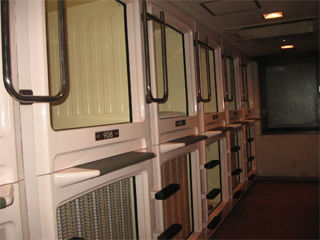
 Save money at a capsule hotel
Save money at a capsule hotel
Booking hotels online makes checking-in painless. Hotels are plentiful in Japan and, depending on your preference, have both western and Japanese-styled rooms (Japanese-styled rooms tend to be cheaper). There are some interesting alternatives to hotels in Japan; Capsule Hotels and ryokans. A stay at a ryokan will give you an authentic Japanese slumber but a cheaper, quirkier alternative in the city is a capsule hotel. You can get your own little pod with a TV for about US$40 a night! Capsule hotels are geared toward businessmen so they are normally English friendly.
A night at a youth hostel is cheaper than a hotel or capsule hotel. They usually have dorms, as well as singles and doubles that are clean and simple. You can book a bed in advance online or inquire at the TIC when you arrive.
TIP: Even if you are used to high-end accommodation, consider staying at a youth hostel. People of all ages and backgrounds stay at hostels in Japan because hotels are on the expensive side. If you are traveling alone, it’s a good opportunity to meet other travelers.
Stay at the right place. With little or no Japanese, picking the right accommodation can be the deal-breaker for a pleasant stay. Whether you want budget or luxury, read reviews when browsing online. Look for key words, such as information center or very helpful staff, in travel reviews and guides. Places that have maps and helpful staff members are sometimes a better resource than a tour guide. Whatever you decide, it’s likely that the staff will know enough English for check-in and basic inquiries.
Electronics
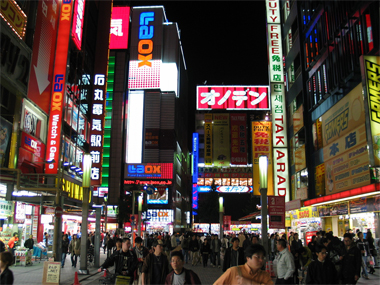
 Akihabara/Electric Town in Tokyo is worth a visit regardless
Akihabara/Electric Town in Tokyo is worth a visit regardless
Tokyo has a whole neighborhood dedicated to electronics called…wait for it…Electric Town (Akihabara). If your old camera is looking shabby check out the options at Bic Camera. Beware: You might feel overwhelmed by too many choices. It’s safe to say that most of the stores have someone who can speak English as these places are used to tourists. Even if you have limited money Electric Town deserves a quick walk through as the selection is a sight behold.
Souvenirs
Samurai swords can be pricey but there are plenty of souvenirs to take back home. Japanese fans of all colors are cheap and easy to pack. Wooden sandals are a great gift for foot-fetish friends. Dolls and games can be found everywhere for children. Haggling isn’t common and most stores have the prices clearly printed next to the item.
A great place to go souvenir shopping in Kyoto is the Gion District. This area is famous for spotting geisha, but wandering around the shops can be fun even if you are low on dough.
TIP: For those trying to save cash; seek out the non-touristy streets or head to small villages. Another idea – buy unique, packable Japanese food at the local supermarket.
Know what you want to see/do
The more you know what you want to see and do, the more satisfying your Japanese experience will be. Do not let the language barrier hinder your visit. Research what Japan has to offer. What activities to you want to participate in? Do you want to witness a sumo match? Or check out the Sapporo Snow Festival? Do you want an adventure to an onsen? Or attempt to tame the deer of Nara? Shuffle through the islands of Okinawa? Figure out what you DO NOT want to miss and ask other travelers, TIC and hotel/hostel staffers for details.
Utilize technology
Japan is a tech-savvy country and if scheduling sans language is proving too difficult try asking Google or any other search engine. With all the travel websites, magazines and blogs, information can be found right at your fingertips with the hotel computer. Whether you are looking for a ferry schedule or proper tea-house etiquette, chances are SOMEONE has written about it. Do be sure to consult more than one source.
TIP: Head to a ‘manga kissa’ for all your tech needs. These cyberspace havens are located throughout Japan. They serve as Internet cafes but if you are in a pinch for cheap accommodation just stay in a cubicle there. You can research your plans, drink coffee, watch movies or just catch up on your sleep. Some of them even have showers!
Take a deep breath
I got lost in the Shibuya Subway Station at 5:00 PM-traffic hour. I kept following the yellow overhead signs to dead ends. Everyone was in a hurry and I couldn’t find an information desk or a relaxed, helpful face. After a frustrating 20 minutes I forced myself to stop and breathe by a bagel shop. Standing against the wall, the attendant took notice and asked if I needed help. I told her I was looking for the west exit, she smiled and demonstrated the way. It might sound simple but sometimes the answer comes when you stop searching.
Smile
Practice your bow and learn key Japanese phrases. A smile and domo arigato can go a long way.